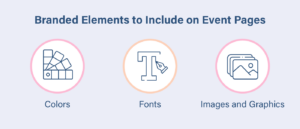Nonprofits rely on digital marketing to reach both new and existing supporters. According to HubSpot, the average organization increased its digital advertising spend by 19% in 2021. This amplified digital presence leads to more online engagement with nonprofits, further solidifying the need for a high-quality website.
It’s crucial to use your nonprofit’s marketing budget wisely to engage supporters with your nonprofit’s events and fundraisers. Effective event pages drive a high return on your marketing investment, providing convenient ways for supporters to learn about, register for, and share the fundraising event.
Because your website is one of your most valuable digital tools, any event pages you add must be visually and tonally cohesive. Let’s explore four strategies you can use to infuse your branding into new event fundraising pages.
1. Use Effective Logo Placement
Your logo should reflect your organization and the work it does in a single, simplistic graphic. Leverage the recognition that your supporters have of your logo to make your event page feel connected to both your mission and the rest of your website.
When creating your event page, remember to choose the placement of your logo carefully. Avoid using the logo too often so you don’t lose the impact of the symbol. To balance impact with brand recognition, consider the following placements:
- Header or navigation menu: These sections both live at the top of the page, meaning that they are one of the first elements supporters see when they visit your website.
- Banner or hero section: This part of the fundraising page webpage is also near the top of the page, but it typically allows for text to be added. This way, you can add a message alongside the logo, such as a short description or slogan for the event.
- Footer: This bottom section of the page is much less prominent, so it’s best to feature the logo in other places as well. Placing it in the footer can remind supporters of the association between the event and your nonprofit and, if you add a link to the logo, provide easy navigation to your homepage.
Your organization can also leverage event-specific logos, helping distinguish the special event from your nonprofit’s other programs and fundraisers. For example, perhaps your organization has been holding an annual raffle fundraiser for the past decade and your supporters are familiar with its unique logo. In these cases, remember to feature both logos on the page to establish that the event is associated with your nonprofit.
2. Incorporate Branded Visual Elements
While your logo is the most obvious and important branded element to include on the event page, there are also other, more subtle visual cues you can use. To reinforce your branding among users, make sure to include other branded elements such as:

- Colours: Your nonprofit likely has a small colour colour palette of three to five shades it uses in its marketing materials. Stick to this small range of colour colours when designing your event page so that it aligns with your website and branding.
- Fonts: Incorporate your designated typefaces and fonts and avoid using more than two fonts per page to keep your designs clean.
- Images and graphics: Feature images and graphics from past events on your event page. Candid photos and graphics are visually appealing and attention-grabbing and supporters can share them to spread the word about your upcoming event.
If your content management system (CMS) doesn’t offer the flexibility needed to design your event pages based on your unique brand, consider switching to a new platform. For example, Kanopi’s WordPress guide recommends selecting a CMS that is capable of handling significant traffic and user engagement, is customizable, and offers a simple editorial and media management system.
3. Keep Messaging Consistent
When planning events and marketing strategies, make sure that your central message aligns with your nonprofit’s mission.
Let’s take a look at a specific example. Perhaps your nonprofit’s mission is to conserve historic landmarks in your community, and you typically promote the message in a more formal, authoritative voice. You are holding a fundraising event in which supporters can pay a fee to attend a guided tour of those landmarks.
While your marketing goals may be to recruit a certain number of registrations or grow your social media presence, you’ll need to pursue those goals using engaging messages that relate to your mission and match your brand’s voice. For example, you might include a headline on your event page that says, “An Evening with History: Landmark Conservation Tours.” Additionally, you could add a copy to the page with a short description of how the event will benefit your ongoing mission.
4. Add Branding to Other Event Materials.
Your event page should feel like a cohesive part of your nonprofit’s overall marketing strategy. Tie your event promotion strategy together by incorporating your branding into other event materials.
Here are some of the digital event resources that you should consider branding along with the event page:
- Social media posts: Incorporate graphics, imagery, or videos related to your mission and the event into your social media marketing strategy. For any high-quality graphics, make sure to include your logo.
- Flyers and posters: These resources are a great way to share the logistical details of your event while reinforcing your branding. Don’t forget to prominently feature the name of your organization, your logo, and other branded elements.
- Thank-you messages: Thanking your donors is a key part of a good retention strategy, but it can sometimes be difficult to reach and engage them after the event. eCardWidget’s guide to donor thank-you emails recommends including your logo and colours in the email—this way, supporters know and trust that the email came from your organization.
Track key performance indicators (KPIs) related to each of these resources to understand which of your marketing methods are most effective. For example, track data such as likes and comments for social media posts and metrics like open and response rates to evaluate the success of thank-you emails.
Lastly, to make sure your website is doing everything it can to support your events and your mission as a whole, consider working with a team of experts. Professional designers can assist with anything from migrating to a new CMS to helping you build attractive, user-friendly event pages.


